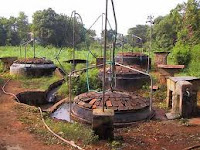2013, August 8
Sanitation program
 |
| Tiago Soares is the promoter of the Project |
This program aims to start a
sustainable local production and installation of septic tanks, toilets and
sinks. This will allow the progressive installation of sanitation in the
different households of the village, and at the same time the development of
new manufacturing processes that can help the economic development of the
village. Molds of the sinks, toilets and septic tanks have been designed and first
prototypes are now under production. The equipment will be made of concrete with
fibers to ensure the appropriate mechanical properties.
In 2013, enough funds have been
raised for the first 50 installations. The program will continue in the medium
and long term with the goal of having all the houses in the village equipped
with a proper sanitation system.
Besides increasing the hygiene and
public health standards, the program will stimulate the creation of a space of
hygiene, privacy and self-esteem in the households. This new room will help
developing the sense of house as more than just a sleeping place.





















